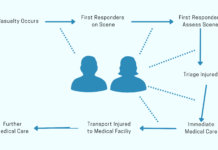We have all had to interact with healthcare at one point or another, whether it is through routine checkups or emergency room visits. Our healthcare system faces the unique challenge of having to accommodate people of many different backgrounds, some unable to express their needs. In this field, underserved and underprivileged populations require increased care and advocacy. Very few know what to look for or ask because of language barriers or panicked physical or mental states. This creates a unique design problem: How do we give a voice to the voiceless?
When I was in high school, my mother accidentally spilled scalding water over her legs. If my family had been educated about medical care, we would have taken her to the hospital instead of urgent care. After my mother was discharged, she still had to understand her prescription medication, manage nutritional needs, check in with providers, and sort through claims and bills filled with medical jargon. These tasks were even more difficult because she was not a native English speaker. Our experience with the healthcare system was fraught with red tape and bureaucracy. Why was the learning process so cold to a person in her most vulnerable emotional and physical state?
The more I researched, the more I realized our issue was one of many. The U.S. Department of Health and Human Services (DHHS) states that nine out of ten people do not understand their health information resulting in additional clinical problems and higher readmission rates. According to the National Institute of Health (NIH), people who do not understand their health information cost the United States $200 billion annually. In 2016, a study from the American Journal of Surgery found that 65% of patients don’t understand discharge instructions. Health literacy becomes even more difficult for non-native English speakers, elders, and those with disabilities. How can people follow instructions they don’t understand?
A plethora of gaps in healthcare knowledge can be bridged by harnessing technology for educational purposes. Integrating design and technology can support those in their most fragmented state by giving them resources to care for themselves, helping them to understand their health information, and building positive coping skills during their recovery process.
Empathy is the building block of the design process. In classrooms, everyone has a different learning style, background, and language proficiency. Healthcare is the same way. Healthcare providers can learn from design principles by communicating in simple, understandable, and actionable language. Poor design is rampant throughout the healthcare sector. Technology and quality instructional design can aid the majority of Americans who do not understand their healthcare information.
How can we help people understand their healthcare information? The concept of cognitive load refers to the amount of mental effort used for a given task. Medical jargon places an increased cognitive weight on those in a fragile physiological state. To minimize the burden on patients, healthcare providers should strive to put themselves in their patients’ shoes and leverage technological and educational resources.
The main topic of this article is the lack of medical literacy that comes with diagnoses and treatments. As the article states, medical jargon places a lot of mental effort onto the patient. This can be applied to hypertension. Many people are diagnosed with hypertension and may even receive medication but still do not fully understand their condition or the severity of it. Further, with a condition such as hypertension that is typically asymptomatic, medical jargon and a lack of understanding makes it difficult to convince patients to keep up with self-monitoring and medication.
This potential to use technology to help people understand their diagnosis is something that is being explored in the realm of hypertension. There are currently many apps that focus on preventative techniques. However, these are typically downloaded by individuals who already are aware of their high blood pressure. I am interested in researching ways technology can assist in educating those who are unaware of their hypertension, as well as the general public for preventative measures.




